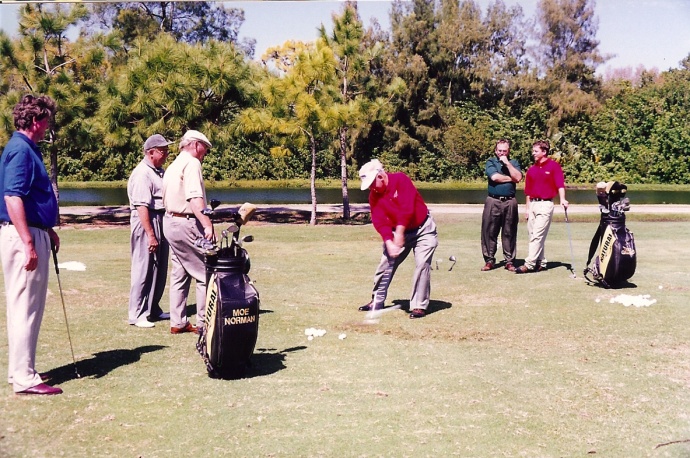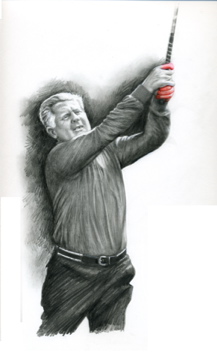Moe’s golf swing is different than most swings you see on television or at your local driving range. At first glance, you know the club positioned a foot behind the ball, and his arms stretched out away from his body. His legs are broad and straight, and his upper body has more tilt than the ordinary golfer. The setup looks unfamiliar and awkward, and you haven’t seen him swing yet.
When he does swing, there isn’t much twisting and turning. His body stays pretty still as his hands move back to shoulder height. Wielding the club like a long hammer Moe braces his legs in the downswing as his body moves a bit forward. His lead knee flexes as his hands bring the club into impact. As the club rushes through the ball, his trail foot stays on the ground as all the way through to the finish. Then when the swing is complete, he extends the arms and clubs skyward pointing to the club toward the target.

Now, what if I told you that Moe’s swing is the most consistent movement to ever strike a golf ball – in the history of the game of golf.
The first three shots I saw Moe hit struck the target from 50 yards. During the same clinic, he drilled a steel pole from 250 yards a dozen times. I told him, “You’re the best I’ve ever seen.”
“I know, I’m the best in the world,” he said.
“How did you learn to do that,” I asked.
“Hard work, you can’t buy it.”
That was the day I went to work. I started to build my swing to model his. When I did, I followed some rules that I still adhere to today. Here is what I believe is the best way to Model Moe.
Copy and Paste – don’t question it
First, take nothing Moe says for granted. Most of Moe’s ideas of the golf swing were his way of explaining the unexplainable. Moe was doing his best to describe his feelings.
Second, try not to judge it until you understand it. Many things in the golf swing don’t make sense, but once you finally know them, they are almost common sense. Have you ever experienced that? (This is where you ask yourself how you could have been so dumb?)
Moe often said, “Swing the handle, not the head, I never swing at the ball, I swing through the ball.”
I found this insight to be a jewel and when I understood Moe’s golf swing. This meant that you have a relationship with the golf club, not the golf ball. If you maintain this relationship, the ball simply gets in the way of the movement of the club.
With this understanding, I began to understand his address position and discovered that some of the things I thought of as “idiosyncratic” were probably “secrets” to great ball-striking and consistency.
Consistency is a characteristic of great ball-strikers and Moe was the personification of it.
Placing the Club Behind the Ball is a key to simplicity and alignment?
When it came to Moe’s golf swing, Moe did something unique at address. He placed the golf club well behind the ball. This club head position established a relationship to the handle of the golf club.

When you look at Moe’s address position with every club, you will see a similar relationship and shaft angle where the head is directly above the club head, and the club aligns with the lead arm.
I found this to be a major geometry. Moe has established a relationship to the handle of the golf club. This angle shows how his hands are ahead of the club head (relative to the target).
Although swing plane is established at address and returned at impact, the address does not affect. There is a lateral element to the golf swing where the hands, while centered at address, are more forward at impact.
Moe found a solution for this dynamic in the golf swing by placing the club behind the ball and by doing so, maintained the relationship of the handle of the golf club to the body.
Remember the pivot point? This stage is a reference point for the golf club as it relates to the body. This relationship is critical when swinging the club into the correct impact position. The pivot point connection establishes an ideal address position relationship. Notice that the pivot point relationship at address places the line of the lead arm and club-shaft in a situation where the club head is in the center of the feet but depending on the club you are hitting. The ball is not there; it is forward of the club head.
Also, notice that from the Down the Line View that the club is also in a perfect single axis where it is on the Single Plane. This pivot point relationship and subsequent single axis are related. Moe’s genius reflected in his ability to do what no other golfer has ever done, place the club behind the ball to simplify swinging on plane.
If the goal is to establish the plane at address and impact the ball on this plane, then you will find it valuable to experiment with the pivot point relationship which will mean placing the club behind the ball.
During one practice session with Moe, I was standing adjacent to him on the driving range where he was hitting balls in the station behind me. I turned to watch him hit, and as he addressed the ball, with my club, I pushed his club-head directly against the ball and said: “hit it from there.”
Moe paused and looked up a bit bewildered. With a moment of thought, he said: “I can’t.”
“Why not?” I questioned.
“It’s not me,” he responded.
“I know it’s not you Moe,” I protested, “but what happens if you start the club from directly behind the golf ball?”
Moe thought for a second. “I take it outside.”
Moe demonstrated by taking the club in an outward movement away from the ball. “This is what happens,” Moe said.
When Moe placed the club behind the ball, he was ensuring perfect club movement away from the ball. With much of golf instruction talking about how it is important to take the club back low to the ground and with a slow rhythm. Moe would say,
“How can it be any lower and slower than that?”
After mastering the address, I began to practice Moe’s movement. I noticed that his trail foot was firmly on the ground through impact.
Both Feet on the Ground at Impact to stabilize the body
A common noticeable characteristic of Moe’s golf swing was his impact position where both feet were firmly flat on the ground. Often interpreted as weight being on his trail (right) foot at impact, the opposite is true. While both feet are flat on the ground, most of the weight of this position is on his left foot.
Defying convention, the feet on the ground at impact is the most stable and perfect body position at impact yet it is only achievable from a single plane position due to the mechanical movement of the golf club on a single plane. Keeping the feet down doesn’t mean that you don’t rotate. It says “turn as much as you can with your feet down.” This allows the lower body to stabilize and the upper body to produce speed.
Often I practiced hitting balls with both feet down all the way through the finish. This helped me feel how the lower body worked through impact. My rules were:
“Left knee flexed, Right foot on the ground, Turn hips as much as possible.” Moe called his lower body movement, “Buckle, Sit, Slide, Bump” for Buckle the lead knee, Lower body moves down (Sit), Lateral movement (Slide), and Bump (Trail hip).
The movement of Moe’s lower body was masterful. By keeping the feet on the ground it limited the movement so he could maximize hip rotation without moving too much.
This position also demonstrates that the spine can maintain its position from address through impact – reducing stress and compression.

In conclusion, when you start copying Moe’s swing, make sure that you master his speech position first. Study and perfect every part of it. As Moe said, “If you don’t have a good address position, you haven’t got anything.”

thanks
LikeLike
You just said it all. I’ll definitely save this to read over and over. Personally, I noticed that one of my biggest “misses” was an “over-the-top” pull likely caused by beginning the swing with the club directly behind the ball in the conventional manner. Now, by starting with the club in the middle of my stance, my first move back is to the inside on plane. My ball position is 4-6 inches in front of that. The ball striking is good and now the focus is on the short-game. Thanks again for enabling Moe’s genius to live on!
LikeLike
So you place your driver head a foot behind the ball at address. I assume that as this is not part of the backswing the club face remains square to the target. The only way I am able to keep the club face square a foot behind the ball and in line with my lead arm is to deloft it. If I dont do this the club face is open as it goes back and inside. Is this correct??.
LikeLike
I don’t. but my ball position isn’t quite as far forward either. While the club appears to be closed at address, it won’t be at impact because of the lateral slide and weight shift combined with the secondary spine tilt.
LikeLike
John, I don’t recommend deporting the club – I recommend using the proper tilt of the upper body to keep the club in line with the arm and NOT deport it.
LikeLike